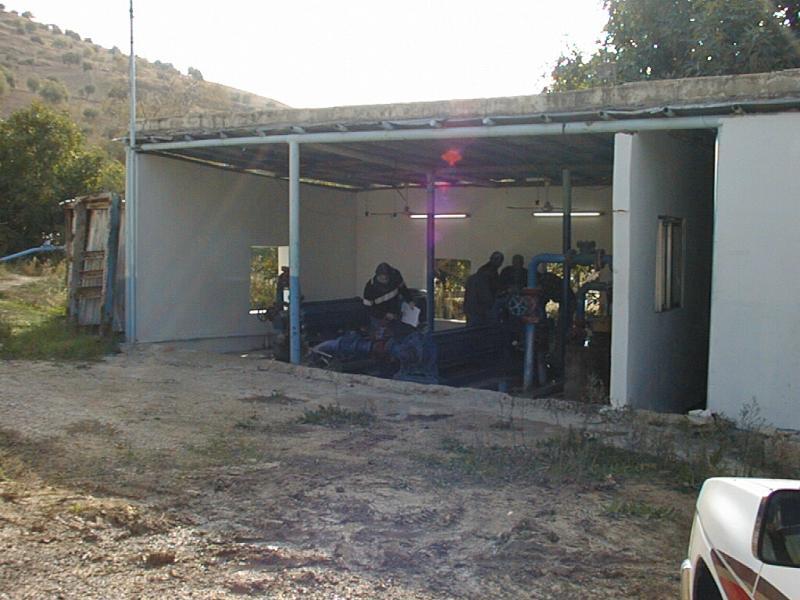
|
by ARNE BATTERMANN
Currently the Al Koura water network consists of 210 km pipeline (DN > 50). The major part of the network consists of galvanized iron (GI) pipes, 32% consist of steel pipes (table 5).
Two pumping stations are supplying Al Koura - the Judayta pumping station in the south of the district and the Oyoun Al Hammam pumping station in the northern part of Al Koura. These two stations are provided by two wells each. Each well is equipped with a flow meter for a documentation of the well production. Figure 7 shows Judayta pumping station.
Appendix 18 gives an overview of the installations at Judayta pumping station.
Two additional booster stations are located in the outermost north and west of the district. Two flow measurement locations are defined in the north and south for documenting the flow out of the district for supplying direction Ajloun or Irbid.
Appendix 19 shall give an overview of the pumping and booster locations of pump and booster stations, wells, water meters and the structure of the distribution network. In spite of extreme elevation differences in the district, capacities of existing reservoirs are not used and high-pressure zones exist in supplying zones.
|
For the Irbid Governorate the quantity of UFW is estimated with 55% on average. Administrative losses have a share of 60% and technical losses of 40% on UFW[11]. Generally a discussion about influences on technical and administrative losses of water distribution systems is necessary in order to demonstrate possibilities for improving the system.
In the following some influences on UFW in Al Koura are highlighted, which have been observed during field visits.
A great part of the water network in Al Koura is lying uncovered on the ground next to streets without any protection of demolition. It has been observed that some pipes go through house walls and other pipes cross streets without any coverage.
Judayta is a village, which is directly supplied by a pumping station 400 m below. No surge protection is installed - water hammer is likely every time the supply is stopped. This increases the danger of bursts (figure 41).
The water network of Al Koura mainly consists of steel pipes (table 5). Most of them are lying on the ground and directly exposed to weathering.
Leakages often result from inadequate repair of bursts. For example, refilling pipe trenches with sand is no matter of course. It might happen that rocks of several tons are used instead. The same applies for new parts of the network.
For the case that the pipe is covered, it is difficult to recognize leakages as the sandstone that forms the terrain contains seams[2].
Leakages are caused by substandard fitting installations.
In this report the water network of Judayta is analyzed. Zones are not clearly separated and the existing zones are not operated in dependency to the hydraulic optimum (section 3.7).
Parts of the network are not well documented. 'Wild' connections between supply zones have been installed, without good or any documentation. Staff members, knowing details about the complex network, are few. Within the scope of this thesis 13.1% of pipes in Al Koura have been updated (table 6).
Pressures up to 41 bar have been documented during the logging campaign in January, 2001 (section 3.7). Some domestic water meters have to resist pressures of more than 30 bar over complete supply intervals. Currently, no pressure reduction valves are installed.
In the following registered influences on nonphysical water losses (section 2) are discussed briefly.
Reduction of administrative losses goes further than improving measurement methods and procedures in direct connection to the water network. In many cases deficiencies in administrative areas are responsible for a huge percentage of high water losses.
A number of the installed water meters do not reflect reliable measurements. Often this results in high pressures. Pressure reduction valves do not exist or are not installed and the meters are not designed to face pressures up to 30 bar (section 3.7).
In section 5.2 the effect of intermittent supply on domestic water meters is analyzed. Inaccuracies have to be confirmed. This survey is described and analyzed in section 5.2.
Frequently the water meters are manipulated by the subscribers. Statistics of the time between January and October, 1999, published in [11] show, that in 70% of illegal cases the water meters in the Al Koura area have been manipulated, in 20% of the cases illegal connections have been installed in front of the meter. This percentage refers to one illegal case out of 88 subscribers.
According to reports by workers of the maintenance team bursts cannot be repaired or are repaired lately because of missing personnel.
According to [11] the illegal connection cases in Irbid and Jerash are alarming. Twenty-five percent of the subscribers are consuming water illegally. Even worse is, that this percentage reflects the convicted cases only. The real percentage of illegal water consumption might be even higher.
There is no prosecution of illegal water consumption. The reason might lay in the public sector structure of the WAJ. A necessity of being economically does not exist in the same way as on the private sector.
Objections by customers on water bills are accepted by the responsible instances of the water authority. Reasons might be missing responsibilities of the personnel in the public water authority and a lack of interest.
According to statistics published in [11] 14.4% of the summarized objections of the complete Irbid governorate are dismissed. In Al Koura only 12.9% are dismissed. This means that the majority of objections (nearly 90%) succeeded.